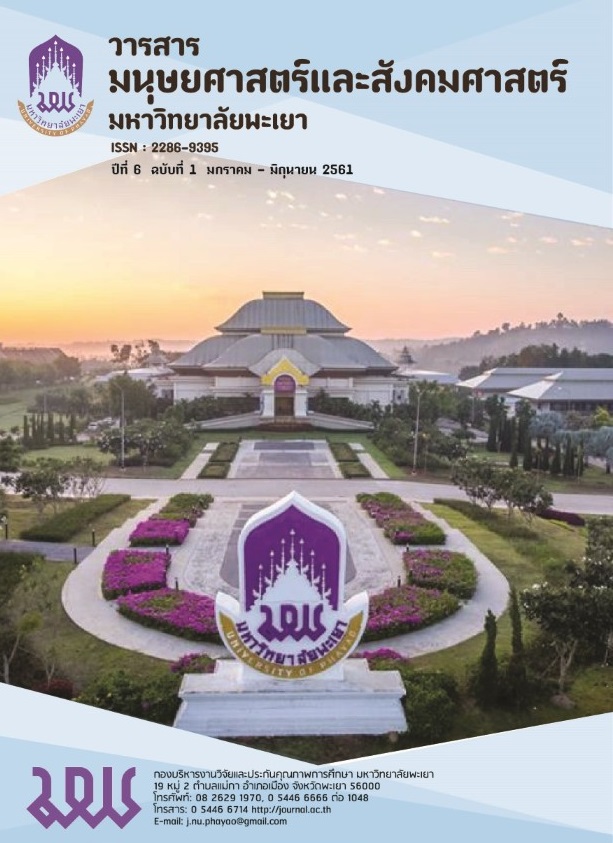A study on characteristics of the traditional media “Jong Pa Ra festival” and Its use in cultural tourism in Mae Hong Son province
Keywords:
Jong Pa Ra festival, Media for development, Participatory communicationAbstract
This study found that there were some differences of Jong pa ra festival between past and present times which were described as follows; people in the community made a jong pa ra by themselves in the past while there is a project that made jong pa ras for people and a parade to celebrate the festival at present. Moreover, Jong pa ra festival in the past showed the believing of Buddhism and aimed to make the happiness to Meung Pon’s people in the level of an individual and a family. At present, the objectives of this festival are to inherit a local tradition and to support a cultural tourism development. Jong pa ra festival had been performed as a media and a message which was adapted in the form and detail but still remained the valuable of the local tradition. Meung Pon’s people accepted and agreed to use Jong Pa Ra festival as a media to advertise and support the tourism. However, they still highly valued and kept their eyes on the methods of the festival to be in a good way. Jong Pa Ra festival created a good partnership between the public sector and people in Meung Pon. Finally, this study recommended that a limitation of media to promote Jong Pa Ra festival was the reason why tourists did not considerably pay attention or interested in this festival as much as it should. The further study should focus on using media to promote and support the local tradition.
References
นุชจรินทร์ ทับทิม. (2553). การสื่อสารอัตลักษณ์ของชุมชนบ้านวัวลาย จังหวัดเชียงใหม่ ผ่านกิจกรรมถนนคนเดิน (วิทยานิพนธ์ปริญญามหาบัณฑิต ไม่ตีพิมพ์เผยแพร่). มหาวิทยาลัยเชียงใหม่, เชียงใหม่.
ปาริชาติ สถาปิตานนท์ และคณะ. (2549). การสื่อสารแบบมีส่วนร่วมและการพัฒนาชุมชน: จากแนวคิดสู่ปฏิบัติการวิจัยในสังคมไทย. กรุงเทพฯ: สำนักงานกองทุนสนับสนุนการวิจัย.
มงคล จันทรบำรุง และสารภี ศิลา. (2545). ความคิดเห็นของชุมชนและบัณฑิตอาสาต่อโครงการจ้างบัณฑิตอาสา และผู้มีประสบการณ์ด้านการเงินเพื่อเสริมสร้างความเข็มแข็งศูนย์สงเคราะห์ราษฎรประจำหมู่บ้าน. กรุงเทพฯ: สำนักงานคณะกรรมการวิจัยแห่งชาติ.
วารินทร์ จิตคำภู. (2541). การอนุรักษ์วัฒนธรรมพื้นบ้าน (ไทยใหญ่) ในทัศนะของกรรมการบริหารสภาวัฒนธรรมอำเภอ จังหวัดแม่ฮ่องสอน (รายงานผลการวิจัย). กรุงเทพฯ: สำนักงานคณะกรรมการวัฒนธรรมแห่งชาติ กระทรวงศึกษาธิการ.
วาลิกา แสนคำ. (2545). การพัฒนาการท่องเที่ยวทางวัฒนธรรมบ้านเปียงหลวง อำเภอเวียงแหง จังหวัดเชียงใหม่ (วิทยานิพนธ์ปริญญามหาบัณฑิต ไม่ตีพิมพ์เผยแพร่). มหาวิทยาลัยเชียงใหม่, เชียงใหม่.
วิไล บุญบรรจง. (2543). การมีส่วนร่วมของประชาชนในการพัฒนาแหล่งท่องเที่ยวบริเวณชายฝั่งทะเลเมืองระยอง อำเภอเมือง จังหวัดระยอง (วิทยานิพนธ์ปริญญามหาบัณฑิต ไม่ตีพิมพ์เผยแพร่). มหาวิทยาลัยเชียงใหม่, เชียงใหม่.
วันทนา เตชะสุวรรณา. (2548). บทบาทของสื่อบุคคลและสื่อประเพณีในการถ่ายทอดวัฒนธรรมประเพณีของชาวบางกอกน้อย: ศึกษาเฉพาะกรณี ชุมชนบ้านบุ (วิทยานิพนธ์ปริญญามหาบัณฑิต) มหาวิทยาลัยธรรมศาสตร์. กรุงเทพฯ.
สมควร กวียะ. (2555). ความรู้ทั่วไปเกี่ยวกับสื่อเพื่อการประชาสัมพันธ์ สำนักงานจังหวัดแม่ฮ่องสอน. รายได้การท่องเที่ยว. สืบค้นจาก http://123.242.182.10/kpi2013/index.php/growth-kpi-6 P.2
สุรีย์ บุญญานุพงศ์ และสุรศักดิ์ ป้อมทองคา. (2539). ประเพณีเพื่อการท่องเที่ยว : จุดเปลี่ยนของระบบความสัมพันธ์ทางสังคม. เชียงใหม่: สถาบันวิจัยสังคม มหาวิทยาลัยเชียงใหม่.
Cohen, John M. and Uphoff, Norman T. (1980). Participation’s place in rural develop: Seeking clarity through specificity. New York: World Development.
Downloads
Published
How to Cite
Issue
Section
License
ผู้นิพนธ์ต้องรับผิดชอบข้อความในบทนิพนธ์ของตน มหาวิทยาลัยพะเยาไม่จำเป็นต้องเห็นด้วยกับบทความที่ตีพิมพ์เสมอไป ผู้สนใจสามารถคัดลอก และนำไปใช้ได้ แต่จะต้องขออนุมัติเจ้าของ และได้รับการอนุมัติเป็นลายลักษณ์อักษรก่อน พร้อมกับมีการอ้างอิงและกล่าวคำขอบคุณให้ถูกต้องด้วย
The authors are themselves responsible for their contents. Signed articles may not always reflect the opinion of University of Phayao. The articles can be reproduced and reprinted, provided that permission is given by the authors and acknowledgement must be given.







